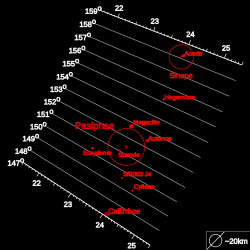Sinope (måne)
| Sinope | |
 Sinope ingår i Pasiphae-gruppen | |
| Upptäckt | |
|---|---|
| Upptäckare | Seth Barnes Nicholson[1] |
| Upptäcktsdatum | 21 juli 1914[1] |
| Uppkallad efter | Sinope |
| Omloppsbana | |
| Banmedelradie | 24,214,390 |
| Excentricitet | 0.2468 |
| Siderisk omloppstid | 769.779665 d |
| Inklination | 155.24° |
| Måne till | Jupiter |
| Fysikaliska data | |
| Diameter | 38 km |
| Area | ~4500 km² |
| Massa | 7.5×1016 |
| Medeldensitet | 2.6 g/cm3 |
| Ytgravitation (ekvatorn) | 0,066 |
| Albedo | 0,04 |
| Temperatur | -149 °C |
Sinope är en av Jupiters månar. Sinope upptäcktes den 21 juli 1914 av den amerikanske astronomen Seth Barnes Nicholson.[1] Månen har en medelyttemperatur på –149 °C.
Referenser
- ^ [a b c] ”Sinope” (på engelska). In depth; by the numbers. NASA Science. 5 december 2017. Arkiverad från originalet den 14 augusti 2019. https://web.archive.org/web/20190814045001/https://solarsystem.nasa.gov/moons/jupiter-moons/sinope/in-depth/. Läst 14 augusti 2019.
| ||||||||||||||
Media som används på denna webbplats
Författare/Upphovsman: User:Eurocommuter, Licens: CC BY-SA 3.0
Pasihae group.
This composite includes the four largest moons of Jupiter which are known as the Galilean satellites. The Galilean satellites were first seen by the Italian astronomer Galileo Galilei in 1610. Shown from left to right in order of increasing distance from Jupiter, Io is closest, followed by Europa, Ganymede, and Callisto.
The order of these satellites from the planet Jupiter helps to explain some of the visible differences among the moons. Io is subject to the strongest tidal stresses from the massive planet. These stresses generate internal heating which is released at the surface and makes Io the most volcanically active body in our solar system. Europa appears to be strongly differentiated with a rock/iron core, an ice layer at its surface, and the potential for local or global zones of water between these layers. Tectonic resurfacing brightens terrain on the less active and partially differentiated moon Ganymede. Callisto, furthest from Jupiter, appears heavily cratered at low resolutions and shows no evidence of internal activity.
North is to the top of this composite picture in which these satellites have all been scaled to a common factor of 10 kilometers (6 miles) per picture element.
The Solid State Imaging (CCD) system aboard NASA's Galileo spacecraft acquired the Io and Ganymede images in June 1996, the Europa images in September 1996, and the Callisto images in November 1997.
Launched in October 1989, the spacecraft's mission is to conduct detailed studies of the giant planet, its largest moons and the Jovian magnetic environment.

